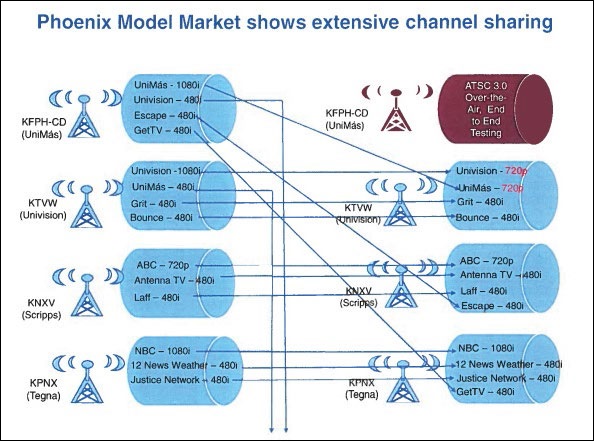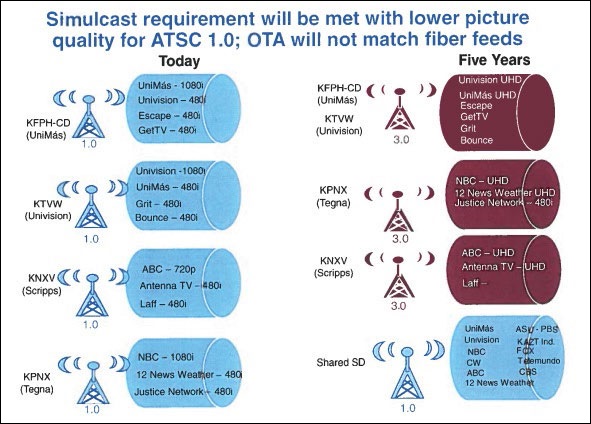Cable Pushes Back Against ATSC 3.0
WASHINGTON—Is cable sandbagging ATSC 3.0? Or are operators just jockeying to limit competition to their evolving data transmission business?
A sequence of recent actions suggests that cable operators are pushing back against collaboration with the Advanced Television Standards Committee’s efforts to enable carriage of the format on MVPD systems. It is unclear whether they legitimately believe, as claimed, that it is “too early” to establish ATSC 3.0 (aka Next Gen TV) retransmission procedures or if the MVPDs are defensively rejecting the standard’s data transmission opportunities as competition to cable’s own digital agenda.
In recent weeks:
• SCTE bluntly told ATSC that it will “defer initiation of the work” concerning carriage of ATSC 3.0 over cable” until the broadcast industry completes its standardization efforts.
• Charter Communications, the second largest cable multisystem operator held a curious meeting with top Federal Communications Commission staff members to explain that proposed 3.0 wireless data delivery plans don’t mesh with existing retransmission agreements. During the FCC meeting, Charter also warned of eventual retransmission problems in the Phoenix model market field trial of 3.0 broadcasts.
• America’s Public Television Stations (the association of non-commercial broadcasters) and the Public Broadcasting Service met with FCC officials to discuss a possible exemption of noncommercial educational licensees from the simulcasting mandate in the NextGen standard.


The spate of cable resistance collectively suggests that the festering 18-month old Next Gen TV rulemaking faces a challenging road ahead. It raises questions about an all-voluntary transition to ATSC 3.0. And since, as some skeptics have observed, the necessary hardware will be relatively inexpensive, cable companies’ recalcitrance to carry ATSC 3.0 services stems from their reluctance to support possible competition.
Madeleine Noland, president of ATSC, dismissed the recent cable maneuvers, pointing out that MVPD operators have had “extensive guest access” to the planning process at ATSC meetings.
“We want full access from the full value chain,” Noland said. “Everybody has to see value. We welcome and hope for input from the MVPDs.” She characterized ATSC as a “very flexible system” that will enable a variety of business goals and rejected claims by cable operators that the standard is not complete yet.
The professional video industry's #1 source for news, trends and product and tech information. Sign up below.
“The standard is ‘done’ as of January 2018,” Noland emphasized, acknowledging that it is “a living, breathing document” with expectations that it will be modified through a “measured revision process that accounts for the need for stability.”
“I feel good that ATSC’s membership wants the correct balance between stability and evolvability,” Noland added. She pointed out that an ATSC specialist group is focusing on redistribution, including the conversion of 3.0 to 1.0. NCTA: The Internet and Television Association was a founding member of ATSC and is a participant in the specialist group.
“Cable operators will have to deal with the fact that channels are moving, as they’ve done with the repack,” Noland said. “The FCC stopped short of saying that 1.0 and 3.0 must be exactly the same. The bottom line is that 1.0 is there and available for at least [five years].”
Given that reality, Noland agreed that “cable operators can say, ‘We don’t need to be ready yet.’”
CHARTER’S OPPOSITION PUTS FOCUS ON DIFFERENCES
The recognition of an extended transition process doesn’t explain why Charter brought up the issue, which is not moving quickly at the FCC.
At the FCC meeting in late July, Kevin Leddy, senior vice president, Technology Planning and Application, and Maureen O’Connell, vice president, Regulatory Affairs for the nation’s second largest cable operator, told FCC staff that the MSO does not intend to carry 3.0 signals since broadcasters have not yet settled on standards. Leddy and O’Connell also told FCC officials from the Office of Engineering and Technology Office, Media Bureau and four Commissioners’ staffs that many of the proposed auxiliary services (such as wireless data transmission) do not fit with existing retransmission agreements.
Charter executives emphasized that ATSC 3.0 “is not backwards-compatible with any existing equipment in the home or in the MVPD ecosystem,” according to their ex parte notice. They also questioned the consumer benefits of the ATSC 3.0 transition, noting that “broadcasters have yet to define which among those possible uses of the new standard they are interested in pursuing.”
According to their filing, Leddy and O’Connell stressed that “many of the uses identified are already available to consumers over the internet [such as delivery of video to mobile devices, movie downloads, data delivery to cars, and data enhancements to video], which could limit demand for ATSC 3.0 consumer equipment.’
In their presentation to the FCC staff, Leddy and O’Connell also pointed to the anomaly they perceive in the current Phoenix Next Gen TV tests now underway. They claimed that “the over-the-air ATSC 1.0 signals involved in the Phoenix test market are different from the ATSC 1.0 signals being delivered by fiber.”
“Because these signals don’t match, there is currently no backup for ATSC 1.0 that can be utilized by MVPDs,” they concluded. Their presentation featured charts illustrating how the shared transmissions of current 1.0 signals would not work in the future 3.0 environment. Those charts were identical to illustrations used in a recent presentation by a top executive of Cox Communications, the major cable TV company in Phoenix.
(Note: Cox Communications operates separately from the Cox Media Group, which recently sold majority stakes in its TV stations to Apollo Global Management, a private equity firm. Cox Media Group is a member of the Pearl TV consortium, which is managing the Phoenix trial.)
When asked for further details about the FCC presentation, Charter officials declined to provide any information—including the reason for the discussion of the Phoenix situation since Charter is not a significant provider in that market. “We have no comment beyond the ex parte filing. It speaks for itself,” a Charter spokesperson said.
Anne Schelle, managing director of Pearl TV, questioned Charter’s (and Cox’s) illustration of incompatibility. She said that the “chart showed us there is no problem when we did the plan.”
Schelle acknowledged that there is “no equipment right now to enable it” [3.0 retransmission], but said that Pearl is working in Phoenix with many organizations, including CableLabs, the cable industry’s research and development organization.
Neither Pearl nor CableLabs would identify the nature or status of their collaboration. “We’ll look at 3.0 implementation with cable in many different ways,” Schelle said. “That will take more time,” although she did not predict a timetable other than noting that Pearl is “starting testing integration and multiple paths.”
FIVE-YEAR WAITING PERIOD
Noland, Schelle and others point out that the rules for ATSC 3.0 implementation include a mandate that broadcasters must continue to transmit in the 1.0 format for at least five more years. Analysts contend that cable operators will eventually figure out how to handle the Next Gen TV transition as they are doing with the repack. Moreover, since the FCC stopped short of saying that 1.0 and 3.0 must be exactly the same, cable operators’ contention that they “don’t need to be ready yet” is a legitimate positioning statement as they develop their 3.0 strategies.
The cable industry’s stance regarding this transition process took on added significance in a memo from the Engineering Committee of the Society of Cable Telecommunications Engineers to ATSC ‘s Noland. The mid-August missive (obtained by TV Technology) came in response to a “Liaison Request Concerning Standardization of ATSC 3.0 For Delivery by Cable.”
“It would be better for us to defer initiation of the work until such time as the broadcast industry efforts are completed,” said the message from the SCTE committee, which did not identify any individual sender. SCTE said it “appreciates” ATSC’s request to develop a coordination process—calling it a reflection of the “history of productive collaboration between ATSC and SCTE.”
“However, we do not feel that the ATSC 3.0 specification in its current form is ready for work in SCTE,” according to the memo. “Specifically, ATSC 3.0 allows a very wide variety of operating points and we request that the broadcast industry develop and provide the necessary constraints, in the form of ‘launch profiles’ along with associated priorities, timeframes for availability, and cadence of expected deployment.”
Beyond the SCTE response, Charter’s FCC presentation spurred other reactions. “The only apparent motivation behind Charter’s filing is its desire to stifle competitive innovation,” said NAB Executive Vice President Dennis Wharton. He also pointed out that MVPDs are not required to carry Next Gen TV signals, and broadcasters transitioning to 3.0 are required to simulcast ATSC 1.0 signals.
ONE Media 3.0 LLC, Sinclair’s high-tech development subsidiary, aaccused Charter of confusing standards with flexible uses for non-television delivery of data.
“If MVPDs and broadcasters are motivated to add an ATSC 3.0 delivered feature or service to the MVPD’s platform, implementation will be achieved in a reasonable timeframe and based on mutual business objectives,” said ONE Media Executive Vice President Jerald Fritz. He pointed out that, “Broadcasters have been working closely with equipment vendors to establish basic television service profiles.”
NON COMMERCIAL 3.0 SERVICE
Public TV stations—which have a history of being aggressive in developing advanced TV technologies—became involved in the 3.0 process as soon as the Next Gen TV rulemaking was issued in February 2018. Lonna Thompson, executive vice president/chief operating officer and general counsel for America’s Public Television Stations, pointed out that public stations face three scenarios, beginning with the differing needs of rural public TV stations, state-wide public TV groups and university-run stations. In particular, the association is looking at delivering 3.0 services to places that don’t have broadband.
The APTS/PBS presentation to the FCC staff focused on the difficulties that some stations will face if they must simulcast 1.0 and 3.0.
“We want to be exempt from simulcast rules,” Thompson said, focusing on the possibility that the requirement could strand some stations. “Licensees know their communities best.” She pointed out that public stations “have been active in market transitions,” including participation in the Phoenix trial.
Thompson also emphasized that public stations have a long history of working in datacasting and other expanded services. She said that stations are working with first responders, the National Guard and other organizations that can use 3.0’s data capabilities.
An NCTA cited the association’s 18-month-old comments to the FCC when the commission opened its Next Gen TV rulemaking, adding that the association would have “nothing more to say” about the current situation.
ATSC’s Noland and others in the broadcast clique cited their long-term support for collaboration with broadcasters, taking hope from the comments of Steve Watkins, Cox Communications’s executive director-Strategic Technology Policy. At an SCTE conference, Watkins focused on the “need to flesh out what’s real and reduce complexity.”
Watkins said, presumably on behalf of his cable company, “If the content/experience is compelling and customers want it, we want to be in a position to deliver it.”
For a comprehensive source of TV Technology’s ATSC 3.0 coverage, see ourATSC3 silo.
Gary Arlen, a contributor to Broadcasting & Cable, NextTV and TV Tech, is known for his visionary insights into the convergence of media + telecom + content + technology. His perspectives on public/tech policy, marketing and audience measurement have added to the value of his research and analyses of emerging interactive and broadband services. Gary was founder/editor/publisher of Interactivity Report, TeleServices Report and other influential newsletters; he was the long-time “curmudgeon” columnist for Multichannel News as well as a regular contributor to AdMap, Washington Technology and Telecommunications Reports; Gary writes regularly about trends and media/marketing for the Consumer Technology Association's i3 magazine plus several blogs.

